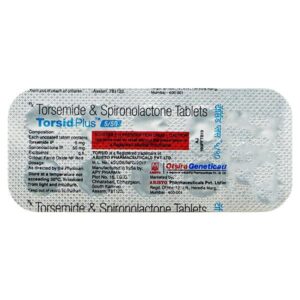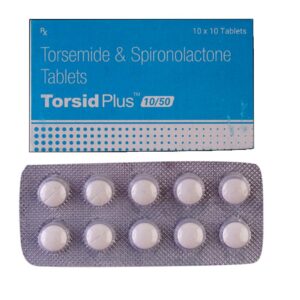SPIRONOLACTONE + TORSEMIDE
Spironolactone: Spironolactone is a medication commonly used for various medical conditions, including high blood pressure, heart failure, and hormonal imbalances such as polycystic ovary syndrome (PCOS) and hirsutism.
The primary mechanism of action of spironolactone is as a potassium-sparing diuretic. It works by blocking the effects of aldosterone, a hormone that promotes the reabsorption of sodium and water in the kidneys while excreting potassium. By inhibiting aldosterone, spironolactone increases the excretion of water and sodium, while reducing the loss of potassium.
The dosage of spironolactone can vary depending on the specific condition being treated. For hypertension, the usual starting dose is 25 to 50 mg once daily, which can be increased up to a maximum of 200 mg per day if necessary. In heart failure, the starting dose is typically 25 mg once daily, with gradual dose titration as tolerated.
When used for hormonal imbalances like PCOS or hirsutism, spironolactone is typically prescribed at higher doses ranging from 100 to 200 mg per day. This is because it also has anti-androgenic properties, meaning it suppresses the effects of male hormones (androgens) in the body. This can help reduce acne, excessive hair growth, and hair loss in women with these conditions.
Like any medication, spironolactone may cause side effects. Common side effects include increased urination, electrolyte imbalances, menstrual irregularities, breast tenderness, and gastrointestinal disturbances such as nausea, vomiting, and diarrhea. Rare but serious side effects may include hyperkalemia (high potassium levels), severe allergic reactions, and liver toxicity.
Since spironolactone is a diuretic, it is essential to monitor electrolyte levels, especially potassium, as excessive potassium loss can lead to complications. Pregnant women should avoid spironolactone use due to potential harm to the fetus.
It is important to note that the use of spironolactone should be under the supervision of a healthcare professional, who will determine the appropriate dosage based on individual needs and monitor for any potential side effects or interactions with other medications.
Torsemide: Torsemide is a diuretic medication commonly used to treat symptoms of fluid retention in conditions such as heart failure, kidney disease, cirrhosis of the liver, and edema (swelling) caused by various factors.
The drug works by inhibiting the reabsorption of sodium and chloride ions from the kidneys, increasing the excretion of water and electrolytes, thereby promoting the production of urine. Torsemide belongs to the class of drugs known as loop diuretics, which have a powerful diuretic effect.
The dose of Torsemide varies depending on the condition being treated and individual patient factors. The usual starting dose for adults is 10-20 mg once daily, which can be increased up to a maximum of 200 mg per day if necessary. It is usually taken orally, with or without food.
As with any medication, Torsemide can cause side effects. Common side effects may include frequent urination, thirst, drowsiness, dizziness, headache, muscle cramps, weakness, low blood pressure, electrolyte imbalances (such as low levels of potassium, sodium, and magnesium), and increased blood sugar levels. It is important to monitor for signs of dehydration and electrolyte disturbances while taking this medication.
Less common but potentially serious side effects may include allergic reactions, severe skin rash, liver problems, jaundice, pancreatitis, and hearing loss. If any unusual or severe side effects occur, it is important to seek medical attention.
It is worth noting that Torsemide can interact with certain medications, such as nonsteroidal anti-inflammatory drugs (NSAIDs), lithium, digoxin, and certain blood pressure medications, so it is important to inform your doctor of all current medications before starting Torsemide.
Overall, Torsemide is an effective diuretic medication used to treat fluid retention in various conditions. It is essential to follow the prescribed dosage and monitor for any potential side effects while taking this medication.


